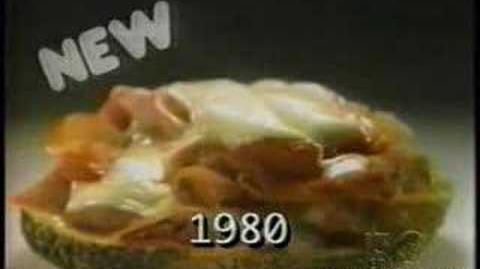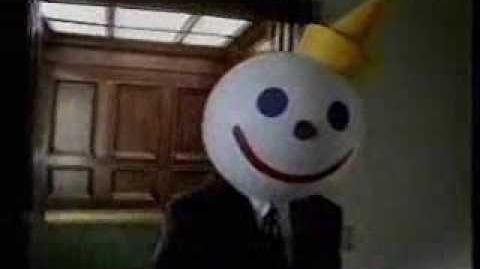An overview of Jack in the Box's advertising campaigns over the years.
1970s

The Jumbo Jack Is Still Too Big To Eat
A commercial for the Jumbo Jack featuring Rodney Allen Rippy (circa 1973).
Television commercials in the early 1970s featured child actor Rodney Allen Rippy. In the commercials, Rippy was seen trying to wrap his mouth around the super-sized Jumbo Jack hamburger. The tag line "It's too big to eat!" (pronounced "It's too big-a-eat!") became a catchphrase. Another spot showed Rippy giggling while singing the song "Take Life a Little Easier," which was released as a single by Bell Records in the fall of 1973 in the wake of the commercial's popularity.[1]
1980s
By the end of the 1970s, Jack in the Box restaurants were being put up for sale in increasing numbers, forcing its parent company Foodmaker to respond quickly to turn the chain around.

Jack In The Box 1980
As a result, around 1980, Foodmaker dramatically altered Jack in the Box's marketing strategy by literally blowing up the chain's symbol, the jack in the box, which dated back to the early San Diego days, in television commercials with the tagline, "The food is better at the Box". Jack in the Box announced that it would no longer compete for McDonald's target customer base of families with young children. Instead, Foodmaker would attempt to attract older, more affluent "yuppie" customers with a higher-quality, more upscale menu and a series of whimsical television commercials featuring Dan Gilvezan. Jack in the Box restaurants were remodeled and redecorated with decorator pastel colors and hanging plants; while the more popular logo, which previously contained a clown's head in a red box with the company text in red either next to or below the box (signs in front of the restaurant displayed the clown's head only), was modified to have the words stacked on top of each other in a red diagonal box while still retaining the clown's head; by about 1981 or 1982, the clown's head was removed from the logo, which would remain until 2009.
1994 reboot
See also: Jack in the Box Universe
The restaurant rebounded in popularity in the mid-1990s, after a highly successful marketing campaign that featured the fictitious Jack in the Box CEO "Jack Box" (voiced by the campaign's creator, Santa Monica advertising executive Richard Sittig), who has a ping pong ball-like head, a yellow clown cap, two blue eyes, a pointy black nose, and a linear red smile that changes with his emotions, and is dressed in a business suit.

Jack In The Box "Jack's Back"
Jack was reintroduced specifically to signal the new direction the company was taking to refocus and regroup after the 1993 E. coli outbreak. In the original spot ("Jack's Back") that debuted in late 1994, Jack ("through the miracle of plastic surgery", he says as he confidently strides into the office building) reclaims his rightful role as founder and CEO, and, apparently as revenge for being blown up in 1980, approaches the closed doors of the Jack in the Box boardroom (a fictionalized version, shown while the aforementioned minimalist theme music from the 1980s Jack in the Box commercials plays), activates a detonation device, and the boardroom explodes in a shower of smoke, wood, and paper. The spot ends with a close-up shot of a small white paper bag, presumably filled with Jack in the Box food, dropping forcefully onto a table; the bag is printed with the words "Jack's Back" in bold red print, then another bag drops down with the Jack in the Box logo from that period. Later ads feature the first bag showing the text of the food item or offer the commercial is promoting.
A commercial was released where Jack goes to the house of a man who has records of calling Jack in the Box "Junk in the Box". When the man shoves Jack yelling "Beat it clown!", Jack chases him outside, tackles him to the ground, and forces him to try Jack's food and confess his deed. The commercial ends with Jack saying "I'm sorry for the grass stains." "Really?" "No". Due to violent references, the commercial was later banned.
The commercials in the now 19-year-old "Jack's Back" campaign (which has won several advertising industry awards) tend to be lightly humorous and often involve Jack making business decisions about the restaurant chain's food products, or out in the field getting ideas for new menu items. While a series of ads claiming to ask when Burger King and McDonald's will change their ways about making their hamburgers featured a phone number, it is unknown whether the caller would actually be connected to Jack himself. In addition, many commercials have advertised free car antenna balls with every meal, thus increasing brand awareness. Often different types of antenna balls were available during a holiday or major event, or themed toward a sports team local to the restaurant. The antenna balls have since been discontinued due to the demise of the mast-type car antenna.
During the height of the now-defunct XFL, one of the continuing ad series involved a fictitious professional American football team owned by Jack. The team, called the Carnivores, played against teams such as the Tofu Eaters and the Vegans.
In 1997, a successful advertising campaign was launched using a fictional musical group called the Spicy Crispy Girls (a take off of the Spice Girls, a British pop music girl group - at the time one of the most popular groups in the world), in comedic national television commercials. The commercials were used to promote the new Jack in the Box Spicy Crispy Chicken Sandwich (now known as Jack's Spicy Chicken), with the girls dancing in "the Jack groove." At the 1998 Association of Independent Commercial Producers (AICP) Show, one of the Spicy Crispy Girls commercials won the top award for humor.
The Spicy Crispy Girls concept was used as a model for another successful advertising campaign called the "Meaty Cheesy Boys" to promote the Ultimate Cheeseburger. The Meaty Cheesy Boys, a mock boy band, were created during an ad campaign featuring an out-of-control advertising executive previously fired by Jack. The same ad exec featured in a spot where a medical doctor made exaggerated claims of the benefits of fast food that it would cure baldness, help trim extra pounds, and remove wrinkles. Jack asks the ad exec incredulously, "Where did you find this guy?" The ad exec responds proudly, "Tobacco company."
In 2000, an ad involved a man washed up on a remote island with only a Jack in the Box antenna ball as company. Later that year, director Robert Zemeckis, claiming the agency had appropriated elements of his Oscar-nominated film Cast Away for the ad, had his lawsuit against the ad agency thrown out.
In April 2006, Jack in the Box launched an ad campaign called Bread is Back, taking a stab at the low carbohydrate diets of recent years.
In 2006, Jack in the Box took use of this perception creating a commercial featuring a typical stoner who is indecisive about ordering. When faced with a decision, the Jack in the Box figurine in his car tells him to "stick to the classics" and order 30 tacos implying that he has the "munchies". This ad later stirred up controversy among a San Diego teen group who claimed that the ad was irresponsible showing a teenager who was under the influence of drugs. To protest, they presented the company with 2000 postcards protesting the ad, despite the fact that it had not aired since the beginning of the previous month. This commercial was redone in 2009 to feature the new logo and the new Campaign.
Another ad touting the chain's milk shakes aired circa 2003 and was shot in the stilted style of a 1970s-era anti-drug spot, urging kids to "say no to fake shakes" and featured "Larry The Crime Donkey," a parody of McGruff the Crime Dog.
In 2007, Jack in the Box began a commercial campaign for their new 100% sirloin beef hamburgers, implying that they were of higher quality than the Angus beef used by Carl's Jr., Hardee's, Wendy's, and Burger King. That May, CKE Restaurants, Inc., the parent company of Carl's Jr. and Hardee's, filed a lawsuit against Jack in the Box, Inc. CKE claimed, among other things, that the commercials tried to give the impression that Carl's Jr./Hardee's Angus beef hamburgers contained cow anuses by having an actor swirl his finger in the air in a circle while saying "Angus" in one commercial and having other people in the second commercial laugh when the word "Angus" was mentioned. They also attacked Jack in the Box's claim that sirloin, a cut found on all cattle, was of higher quality than Angus beef, which is a breed of cattle.
During Super Bowl XLIII on February 1, 2009, a commercial depicted Jack in a full body Cast after getting hit by a bus. The closing shot encouraged viewers to visit a company website designed to encourage him to get better. At the same website, one can view different videos that speak of Jack's condition. These videos include a cell phone video of Jack's accident. Also, previously run commercials of Jack include a disclaimer that reads "Recorded before Jack's accident." After a month in a coma, Jack woke up when his second-in-command, Phil, thinking Jack wasn't aware yet, revealed he was changing the name of the chain to "Phil in the Box". This woke Jack up, and he began to strangle Phil, shouting "PHIL IN THE BOX?! I DON'T THINK SO! SOMEBODY FIND MY PANTS! I GOT WORK TO DO!".
Shortly after the "awakening", it was revealed that the corporate website would be relaunched, and the company would get a new logo, on March 16, 2009.
In October 2009, Jack in the Box debuted a popular commercial to market their "Teriyaki Bowl" meals. The commercial features employees getting "bowl cut" hair cuts. At the end of the commercial, Jack reveals that his "bowl cut" is a wig, to the dismay of the employees.
References
| This page uses Creative Commons Licensed content from Wikipedia (view authors). |
